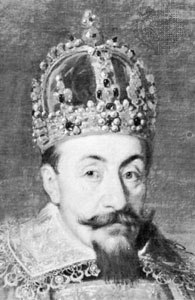Muscovy Crown

The so-called Muscovy Crown (
History
The Muscovy Crown was the type of corona clausa, made in the form of the rims covered with the globe and a cross on their intersection.
One of the gems from the crown became the property of Jan Kazimierz Krasiński, Grand Treasurer of the Crown.[1] It was in the possession of the Krasiński family till the 19th century.[1] Later it was given to Tsar Nicholas I of Russia by Wincenty Krasiński and found its place in the collections of the Kremlin Armoury in Moscow.[1]
References
- ^ ISBN 83-03-02021-8.
- ^ ISBN 83-03-01914-7.
- ^ Margaret Odrowaz-Sypniewska. "Poland's Crowns". www.angelfire.com (in Polish). Retrieved 2009-02-16.
Further reading
- Jerzy Lileyko. Regalia Polskie. Warszawa 1987. ISBN 83-03-02021-8(in Polish)
- Janusz Miniewicz. Tajemnica polskich koron. Czy jest szansa ich odnalezienia?. Nowy Sącz 2006. ISBN 83-924034-2-8(in Polish)
- Michał Rożek. Polskie koronacje i korony. Kraków 1987. ISBN 83-03-01914-7(in Polish)
External links
![]() Media related to Muscovy Crown at Wikimedia Commons
Media related to Muscovy Crown at Wikimedia Commons
